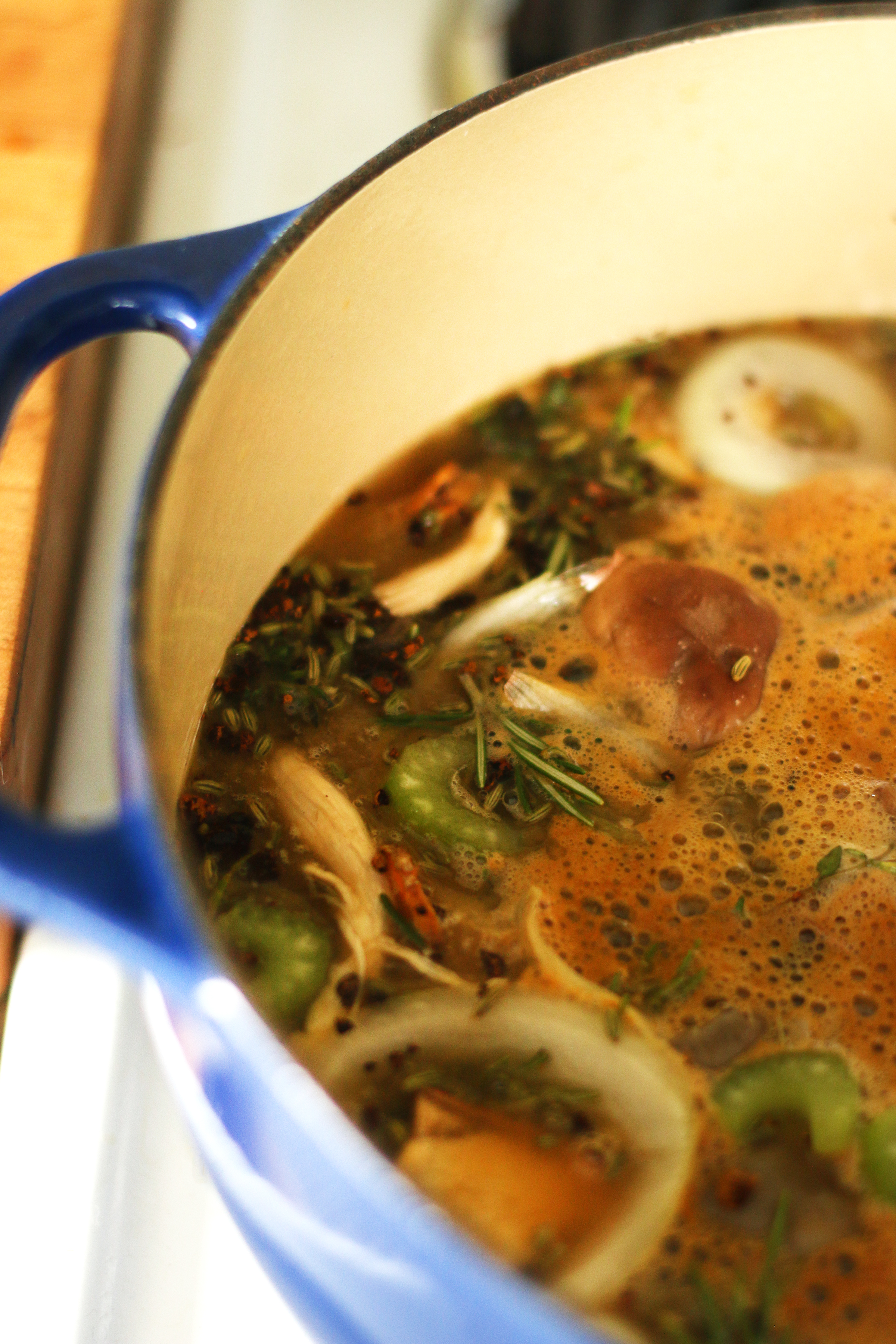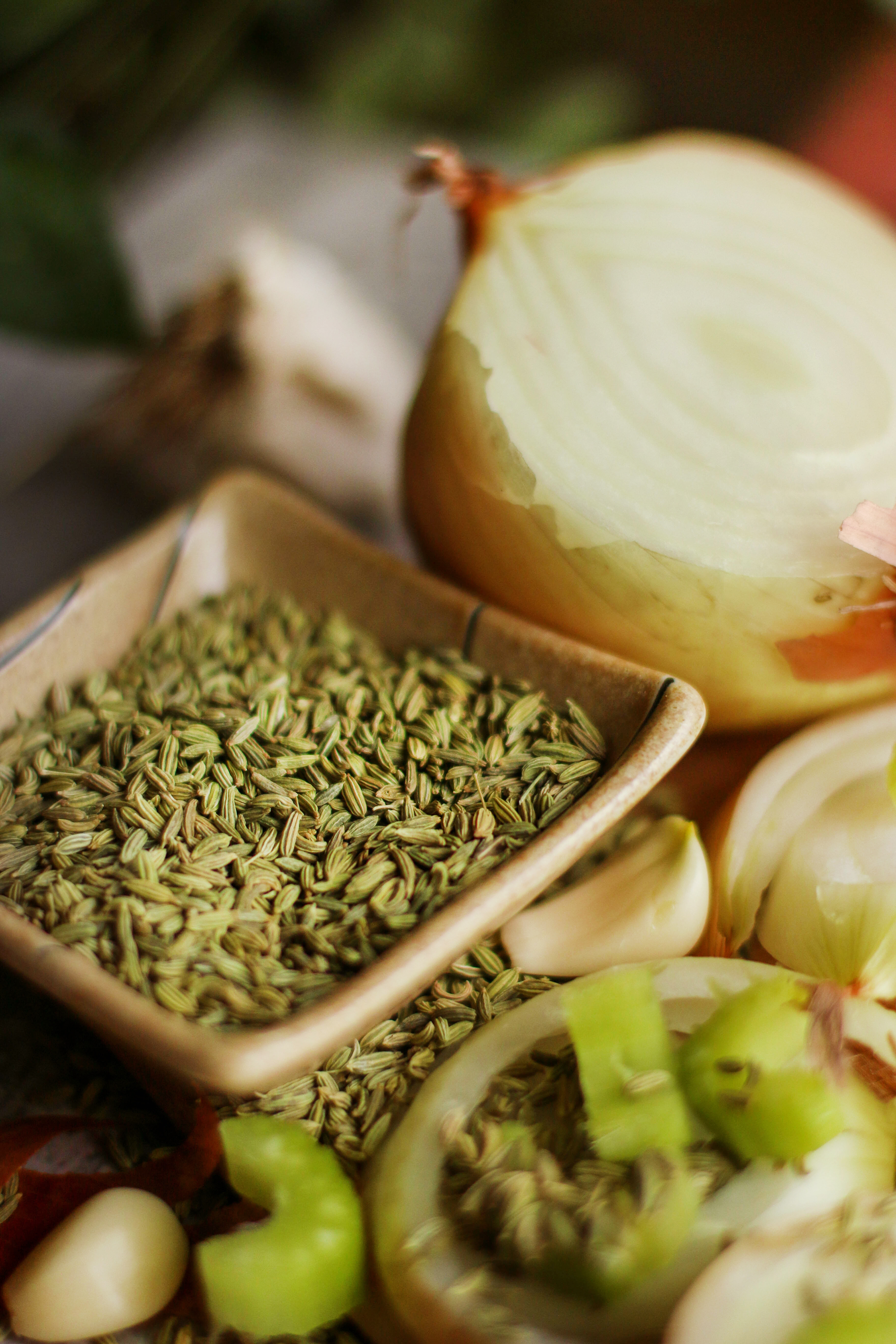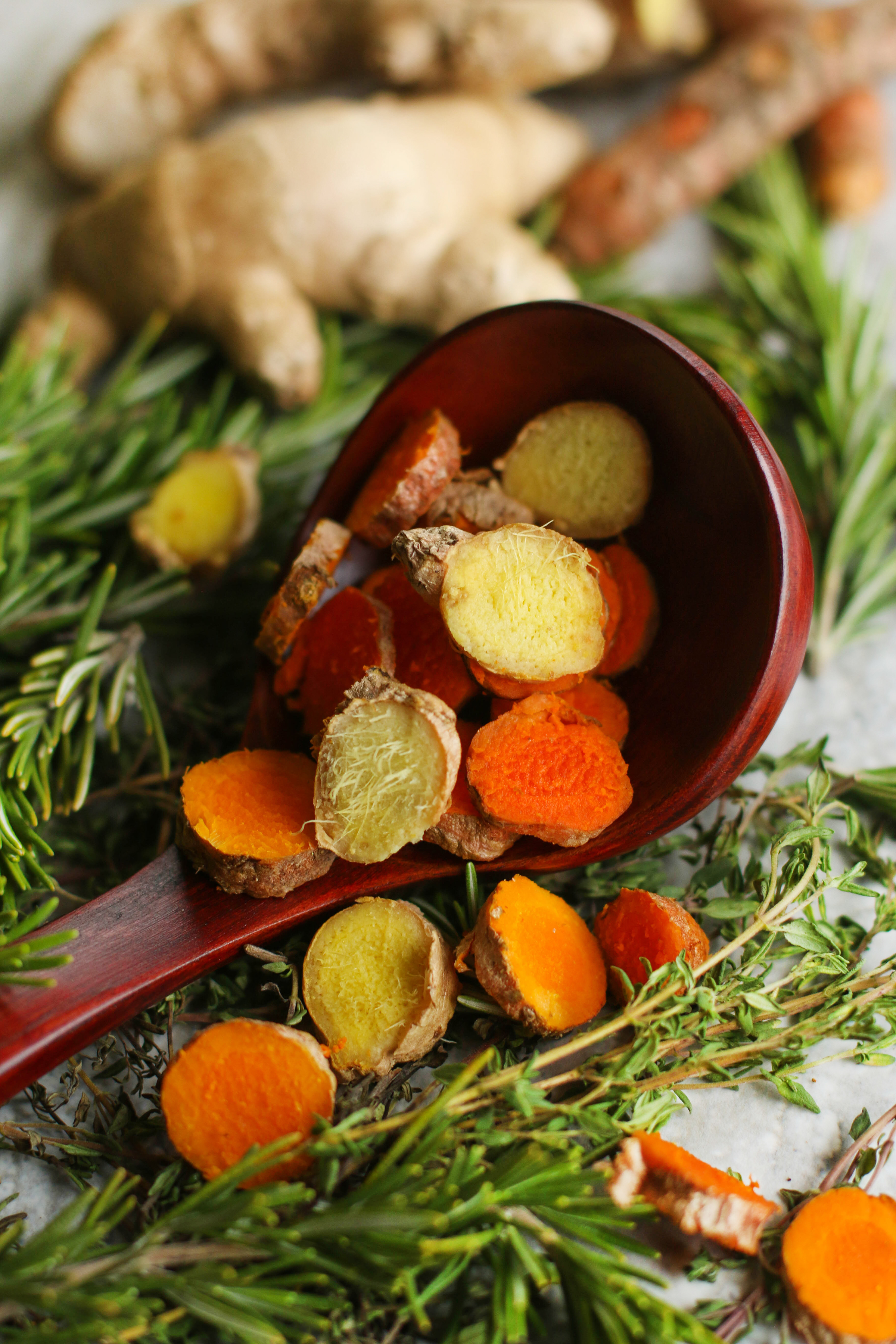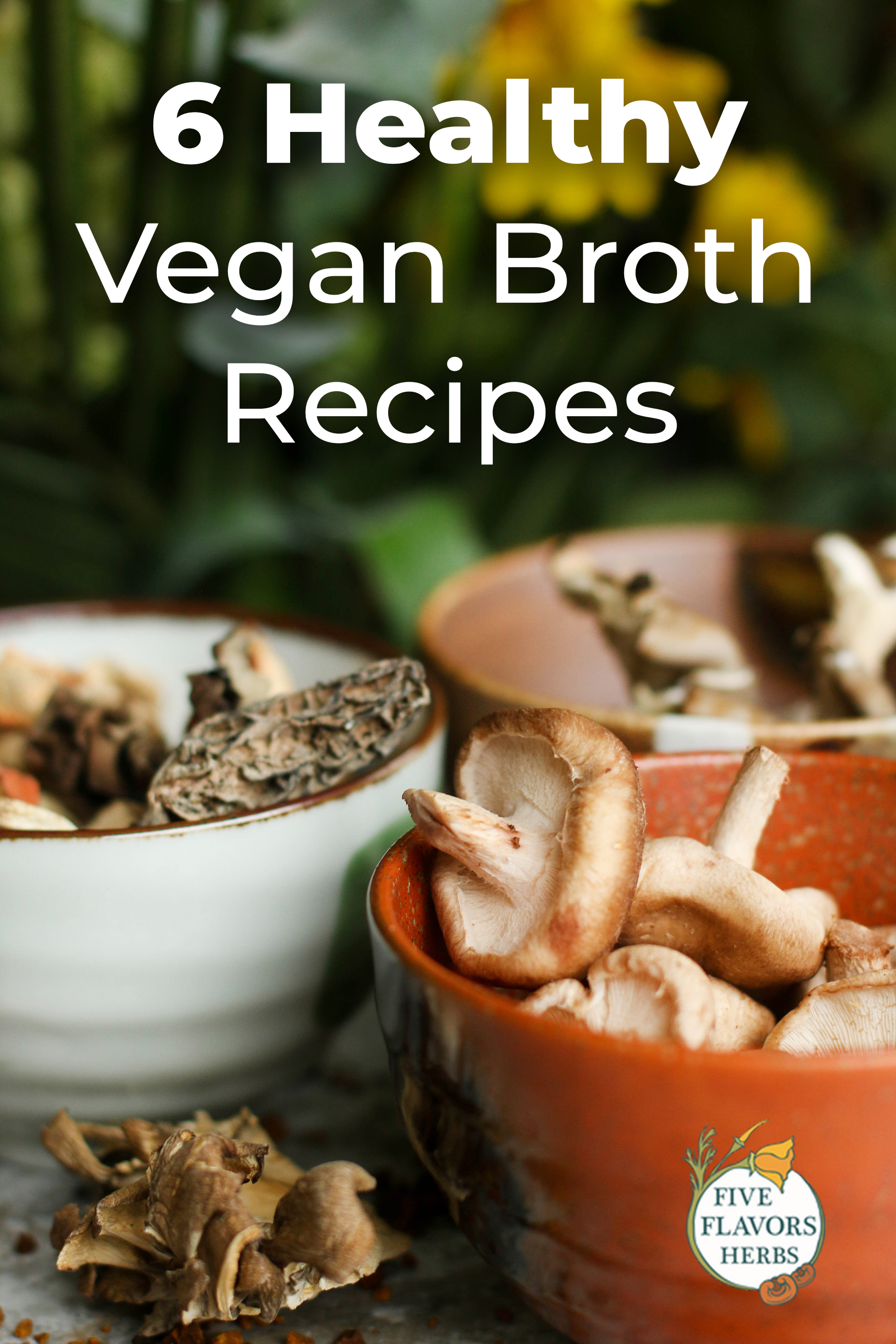Stocks, broths, and soups offer countless delicious and nutrient-dense possibilities for optimizing wellness year-round. During the colder times of year, or when we are feeling poorly, stocks and soups are a wonderful way to warm the body to support optimum digestion and immune function, and to accelerate the absorption of crucial nutrients. No wonder cultures around the world use soups as a delivery system for wellness!
In our earlier Epic Bone Broth blog, we outline some of the benefits of animal-based broths. While there’s obviously no such thing as vegan bone broth, we can offer a number of suggestions for combining plant-based alternatives to bones with complementary herbs and vegetables to support the digestive tract, immune system, nervous pathways, and musculoskeletal system. With some practice, it’s easy to draw from different food cultures to expand the palate in order to access sophisticated, yet accessible, flavor medleys. We invite vegans, vegetarians, and omnivores alike to explore these plant-based options for nourishment.
What to Do with Broth
Broths and stocks can be used not only as the base for soups, but also for cooking grains or pulses. They can also be sipped on their own, especially during a fast or cleanse, or when you’re under the weather. Think of them as tasty herbal teas that deliver medicinal benefits!
How to Make Broth with Plant-Based Ingredients
For any given recipe, consider picking a few ingredients from two or three of the categories below—seaweeds, mushrooms, vegetables, herbs, and spices—with an eye toward flavor alignment and therapeutic intent. For example, you might combine sea vegetables, mushrooms, and aromatic herbs for immune support, or you might opt for seaweed, spices, and vegetables to warm and stimulate digestion.
When it comes to cooking plant-based stocks, it’s important to remember that vegetables and herbs are more delicate than bones—with the exception of woody fungi like reishi, which can take a lot of time and pressure to fully extract. Generally, you won’t need more than an hour in an open pot, or 30 minutes in a pressure cooker, to make a tasty plant-based stock. The finished product degrades quickly, so be sure to use your broth within two days or freeze it as soon as it cools. Chop the constituents into small pieces to enhance extraction over a larger surface area (using the “pulse” mode on a food processor can help speed this up!). Use about a half-pound (if measuring by weight) or one quart (if measuring by volume) of chopped fresh vegetable matter for every two quarts of water. For broths based on dried mushrooms or seaweed, use about one-quarter of the plant matter to the same volume of liquid. Remember that you will lose liquid as your broth simmers and condenses (often around one-fourth of your starting volume), so plan accordingly to make sure you end up with the amount you want.
Read on for some of our favorite nutritious ingredients to include in vegan stocks, followed by some of my favorite delicious recipes!
Best Ingredients for Plant-Based Broths
SEA VEGETABLES
Informally known as "seaweed," these edible algae are incredibly nutritious! They impart a rich texture to vegetarian stocks (which can otherwise be rather thin) and an umami flavor, a savory and satisfying quality that would otherwise come from bones or meat. Two of my favorite varieties are kombu and nori.
Kombu (Laminaria spp, a.k.a. "brown kelp") holds a special place in Japanese cooking. Rich in iodine, iron, and potassium, kombu provides essential minerals for bone, blood, and thyroid health. It is also rich in dietary fiber (which comprises up to 30% of its total weight) and is considered a prebiotic that feeds healthy gut bacteria. Constituents specific to seaweeds known as “alginates” include laminarin, which has been studied for lowering blood pressure and cholesterol. Fiber and alginates together promote bowel health via bulking laxative and demulcent effects.
Nori (Porphyra spp, a.k.a. "red algae") is probably the best known seaweed, loved as a snack and as a wrapping for sushi. Unprocessed nori (i.e., crinkly fronds, rather than the papery sheets used for snacking and sushi) is a wonderful addition to stocks for its exceptional nutritional content, which includes A and B-complex vitamins (pyridoxine, riboflavin, folic acid, thiamin, and niacin), omega-3 fatty acids and protein, and minerals such as iodine, manganese, phosphorus, and iron.
(A few words of caution about seaweeds. Because of their high iodine content, they are great to include in a vegan diet, especially if you avoid iodized table salt. However, if you suffer from a thyroid condition, be cautious about consuming excessive amounts of seaweed, and talk to your healthcare practitioner about the pros and cons of iodine in your diet. Additionally, if you take medications for blood pressure, you may need to watch out for additive effects or electrolyte changes. Again, this is a situation in which to consult your physician. Finally, due to widespread contamination of our oceans, avoid harvesting your own seaweed without expert guidance, and purchase certified organic seaweed whenever possible.)
MEDICINAL MUSHROOMS
The mycelia and fruiting bodies of many edible and woody fungi have broad-spectrum health benefits, from immune-supporting beta-glucans to important vitamins and minerals, including selenium, potassium, vitamin D, and B vitamins. Countless studies point to the benefits of mushrooms for the immune system, a healthy inflammatory response, cardiovascular health, and normal blood sugar. If you take medications for hypertension or diabetes, blood thinners, or immunosuppressants, talk to your physician before consuming large quantities of medicinal mushrooms.
Edible mushrooms can be added while cooking stock, or simmered afterwards to enjoy in a finished soup. Delicious options include shiitake (Lentinus edodes), maitake (Grifola frondosa), and oyster mushroom (Pleurotus ostreatus). If you have these dried, either whole or powdered, simmer in your stock and strain at the end. When using these mushrooms fresh, saute in olive oil on the side (a little salt and thyme makes them extra delicious), then add as a topping to your soup.
Woody fungi such as reishi (Ganoderma lucidum), turkey tail (Coriolus versicolor), and chaga (Inonotus obliquus) are extra fibrous and need to be thinly sliced or powdered to extract the medicinal polysaccharides. Using a pressure cooker and a small amount of baking soda (something alkaline) can aid in extraction and also speed the stock-making process. You’ll want to strain these out with the other stock constituents, rather than leaving them in to eat.
VEGETABLES
We all know that vegetables are good for us—science backs this up, especially when it comes to heart health. I love using the bits and ends of vegetables I cook in other dishes for stock. Throughout the week, I toss the peels and ends of onions, leeks, carrots, celery, parsley, and greens into a resealable bag and store in the freezer until I’m ready to make stock (often on Sunday as I prepare food for the rest of the week). Many of these vegetables are typical parts of a “mirepoix,” the classic base for French soups and many other dishes. They are also rich in aromatics and prebiotics that make soup stock tasty and nourishing. Onions, leeks, and garlic are part of the allium family, the members of which boast a wealth of organosulfur compounds and flavanols that support cardiovascular health. Alliums and root vegetables like carrots and burdock are rich in prebiotics including inulin and arabinogalactan polysaccharides that are food for “good” gut bacteria. And don’t forget about aromatic celery and fennel, which round out the flavor profile and provide an excellent source of vitamins and minerals!
CULINARY HERBS & SPICES
For thousands of years, humans have been incorporating herbs and spices into cuisine not only for their flavor, but for specific health benefits as well. Here are some of our favorites for soup stock.
Ginger (Zingiber officinalis, rhizome) is one of the oldest home remedies used around the world. It imparts a warm, sweet, and spicy flavor to any decoction, including soups, simmered sauces, and tea blends. Terpenes and phenolic compounds contribute to its fragrance and powerful anti-inflammatory and immune-supporting properties, as well as to ginger’s ability to soothe nausea and other forms of digestive distress, from gas and bloating to tummy bugs.
Turmeric (Curcuma longa, rhizome) is an important cooking spice and coloring agent around the world that has become increasingly popular as an anti-inflammatory supplement. Curcumin and related curcuminoids have been extensively studied in relation to many health conditions, including cardiovascular and liver problems, discomfort and inflammation, and immune function. Because turmeric quickly passes out of the body, consuming it frequently and combining it with black pepper and healthy fats is recommended. Consider sauteing fresh or dry turmeric in olive oil with black pepper prior to adding other ingredients and water to your stock pot to enhance absorption.
Rosemary (Rosmarinus officinalis, aerial portions) contains volatile oils, phenolic compounds, flavonoids, and terpenes, making it an excellent antioxidant and germ-fighting botanical. Warming and stimulating to the digestion and the circulatory system, rosemary not only enhances digestion but also opens the mind and lifts the mood. It combines well with parsley, sage, and thyme to create a delicious bouquet for European-flavored dishes. It can be overpowering, so use a small sprig at a time to get the right flavor balance.
Thyme (Thymus vulgaris, aerial portions) is another favorite germ-fighting and antioxidant herb for cooking that goes well with almost anything. Thyme is especially supportive to the oral mucosa and respiratory tract by combating germs and thinning phlegm, making it a great addition to stocks during cold and flu season or for individuals with gum or sinus complaints.
MINERALIZING HERBS:
The plant world offers multiple vegan alternative sources for the essential minerals found in animal-based bone broths, including calcium, iron, magnesium, and silica. In addition to supporting hair, teeth, nails, and bones, these minerals can be soothing to the nervous system and promote healthy energy levels.
Oats (Avena sativa), can be used to produce a mildly sweet, deep green broth, using either their milky seed heads or dry oatstraw In our West Coast neck of the woods, the surrounding fields are rich with wild oats ripe for harvesting! A simple peeling off of the milky tops into a bag results in mounds of spiky green seed heads, which can be processed fresh into tincture or dried for teas and soups later in the year. Oats soothe frayed nerves and support a good night’s sleep without causing drowsiness. They also help you access the energy of spring when you’re in a slump. We love to enjoy the benefits of oats in our Sustainable Energy adaptogen formula and our nootropic Clarity Tincture for cognitive support.
Nettle (Urtica spp, leaf) has been consumed for millennia across the globe. Famously, Saint Columba of Ireland (circa 500 CE) drank nettle broth daily. A true superfood, nettle leaves are exceptionally high in protein, iron, chlorophyll and carotenoids, vitamins A, C, D, E, F, K and B-complexes, selenium, zinc, iron and magnesium. Nettles have a long tradition of use as a nourishing tonic in cases of general debility and anemia, for encouraging breast milk production, and for helping with chronic inflammatory conditions.
Horsetail (Equisetum arvense, aerial portions) is rich in calcium and silica and has a longstanding reputation for supporting tissue health. Contemporary research on this ancient plant has demonstrated improved bone density in both human and animal trials, compared with calcium supplementation alone. Silica is an important cofactor in building healthy collagen, which may explain horsetail’s use for strengthening sinews and recovering from soft tissue injuries. Horsetail is a potent diuretic, so use caution and consult a physician if you take blood pressure medications or have kidney problems.
6 Vegan Bone Broth Recipes
Each recipe is for two quarts of stock, approximately enough for one pot of soup to feed six to eight people later on.
1. SEAWEED & SHIITAKE DASHI BROTH RECIPE
This aromatic umami broth works wonders as a base for miso or udon noodle soup. It's also delicious on its own with a spoonful of miso paste stirred in.
Makes 2 quarts.
Ingredients
- 2 ½ qts. water
- ½ cup dried kombu
- ½ cup dried nori
- 1 cup dried shiitake mushroom
- 2 Tbsp. fresh ginger, sliced
- 1 Tbsp. tamari or shoyu
Directions
- Combine water and other ingredients in stock pot.
- Cover pot and bring to a boil.
- Lower heat and simmer 45 minutes.
- Remove from heat.
- Once cool, strain out and compost solids.
- Use broth within 2 days or freeze right away.
2. PREBIOTIC BROTH RECIPE
This root-vegetable medley feeds your gut bacteria—and your soul too!
Makes 2 quarts.
Ingredients
- 2 ½ qts. water
- 1 burdock root, chopped
- 1 medium carrot, chopped
- 1 onion, chopped
- 1 leek, chopped (or use green onion tops saved from other dishes)
- 4 cloves garlic, smashed and chopped
- 2 sprigs fresh thyme (or 1 tsp. dry)
- ½ cup dried kombu
Directions
- Combine water and other ingredients in stock pot.
- Cover pot and bring to a boil.
- Lower heat and simmer 45 minutes.
- Remove from heat.
- Once cool, strain out and compost solids.
- Use broth within 2 days or freeze right away.
3. VEGAN MOCK CHICKEN STOCK RECIPE
Classic flavors blend to scratch the itch for homemade “chicken” soup or a flavorful stock for pureed squash soup.
Makes 2 quarts.
Ingredients
- 2 ½ qt. water
- 2 celery stocks
- 1 onion, chopped
- 1 medium carrot, chopped
- ½ bunch parsley, chopped (a great way to use leftover stems!)
- 2 sprigs fresh thyme (or 1 tsp. dry)
- 2 sprigs fresh sage (or 1 tsp. dry)
- 1 stem fresh rosemary (or ½ tsp. dry)
- ½ cup nori
Directions
- Combine water and other ingredients in stock pot.
- Cover pot and bring to a boil.
- Lower heat and simmer 45 minutes.
- Remove from heat.
- Once cool, strain out and compost solids.
- Use broth within 2 days or freeze right away.
4. MINERALIZING BROTH FOR HAIR, SKIN & NAILS
Drink this broth as a tea or add to soups or grain dishes to support hair, skin, and nails. It’s also a great rejuvenating recipe when you’re feeling weak or depleted, such as recovering from illness or after a heavy menstrual cycle.
Makes 2 quarts.
Ingredients
- 2 ½ qt. water
- ½ cup dried nettles (or 2 cups fresh)
- ½ cup dried oat tops and/or oatstraw (or 2 cups fresh)
- ¼ cup dried horsetail (or 1 cup fresh)
- ½ cup dried kombu
- ½ cup dried nori
Directions
- Combine water and other ingredients in stock pot.
- Cover pot and bring to a boil.
- Lower heat and simmer 45 minutes.
- Remove from heat.
- Once cool, strain out and compost solids.
- Use broth within 2 days or freeze right away.
5. SOOTHING BROTH FOR INFLAMMATION
This is a great way to incorporate the benefits of turmeric on a regular basis to soothe aches and pains and support optimum immune function.
Makes 2 quarts.
Ingredients
- 2 ½ qt. water
- 2 Tbsp. dried turmeric (or 4 Tbsp. fresh chopped)
- 4 Tbsp. fresh ginger, chopped
- 4 Tbsp. dried reishi mushroom powder (or 1 oz. dried slices)
- 2 sprigs fresh rosemary or (1 tsp. dried)
- 1 tsp. black peppercorns
Directions
- Combine water and other ingredients in stock pot.
- Cover pot and bring to a boil.
- Lower heat and simmer 45 minutes.
- Remove from heat.
- Once cool, strain out and compost solids.
- Use broth within 2 days or freeze right away.
6. BREATHE EASY LUNG SUPPORT BROTH
Support the respiratory tract in clearing congestion and easing cough.
Makes 2 quarts.
Ingredients
- 2 ½ qt. water
- 1 cup dried shiitake mushroom
- 1 onion, chopped
- 2 Tbsp. fresh ginger, chopped
- 4 cloves garlic, smashed and chopped
- 4 sprigs fresh thyme (or 2 tsp. dried)
- 2 sprigs fresh sage (or 1 tsp. dried)
Directions
- Combine water and other ingredients in stock pot.
- Cover pot and bring to a boil.
- Lower heat and simmer 45 minutes.
- Remove from heat.
- Once cool, strain out and compost solids.
- Use broth within 2 days or freeze right away.
PUT YOUR NEW BROTH CREATIONS TO WORK:
TRY THESE CONGEE RICE RECIPES FOR DIGESTION
You might also enjoy:
- Herbal Tinctures for Natural Health Support
- Bedtime Routine Tips & Natural Sleep Aids
- 3 Drink Recipes with Medicinal Mushrooms
Written by Ingrid Bauer, M.D., M.S.: With experience that bridges Western and Eastern medicine, Ingrid brings rigorous scientific knowledge to Five Flavors Herbs. A graduate of the UC Berkeley/UCSF Joint Medical Program and the American School of Herbalism in Santa Cruz, CA, Ingrid integrates plant-based medicine into mainstream healthcare. She is passionate about bringing holistic care to people from all walks of life. Her master’s research focused on Latino health beliefs and traditional medicine at a bilingual clinic in Oakland, CA, and she teaches workshops about herbal medicine at conferences and schools.
Citations:
Aguirre, M., Bussolo de Souza, C., & Venema, K. (2016). The Gut Microbiota from Lean and Obese Subjects Contribute Differently to the Fermentation of Arabinogalactan and Inulin. PLoS ONE, 11(7). https://doi.org/10.1371/journal.pone.0159236
Arbabzadegan, N., Moghadamnia, A. A., Kazemi, S., Nozari, F., Moudi, E., & Haghanifar, S. (2019). Effect of equisetum arvense extract on bone mineral density in Wistar rats via digital radiography. Caspian Journal of Internal Medicine, 10(2), 176–182. https://doi.org/10.22088/cjim.10.2.176
Blekkenhorst, L. C., Bondonno, C. P., Lewis, J. R., Devine, A., Zhu, K., Lim, W. H., Woodman, R. J., Beilin, L. J., Prince, R. L., & Hodgson, J. M. (2017). Cruciferous and Allium Vegetable Intakes are Inversely Associated With 15‐Year Atherosclerotic Vascular Disease Deaths in Older Adult Women. Journal of the American Heart Association: Cardiovascular and Cerebrovascular Disease, 6(10). https://doi.org/10.1161/JAHA.117.006558
Blekkenhorst, L. C., Sim, M., Bondonno, C. P., Bondonno, N. P., Ward, N. C., Prince, R. L., Devine, A., Lewis, J. R., & Hodgson, J. M. (2018). Cardiovascular Health Benefits of Specific Vegetable Types: A Narrative Review. Nutrients, 10(5). https://doi.org/10.3390/nu10050595
Hobbs, Christopher. https://www.christopherhobbs.com/library/featured...
Kowalczyk, A., Przychodna, M., Sopata, S., Bodalska, A., & Fecka, I. (2020). Thymol and Thyme Essential Oil—New Insights into Selected Therapeutic Applications. Molecules, 25(18). https://doi.org/10.3390/molecules25184125
Kregiel, D., Pawlikowska, E., & Antolak, H. (2018). Urtica spp.: Ordinary Plants with Extraordinary Properties. Molecules : A Journal of Synthetic Chemistry and Natural Product Chemistry, 23(7). https://doi.org/10.3390/molecules23071664
Nieto, G., Ros, G., & Castillo, J. (2018). Antioxidant and Antimicrobial Properties of Rosemary (Rosmarinus officinalis, L.): A Review. Medicines, 5(3). https://doi.org/10.3390/medicines5030098
Nikkhah Bodagh, M., Maleki, I., & Hekmatdoost, A. (2018). Ginger in gastrointestinal disorders: A systematic review of clinical trials. Food Science & Nutrition, 7(1), 96–108. https://doi.org/10.1002/fsn3.807
Pulido-Moran, M., Moreno-Fernandez, J., Ramirez-Tortosa, C., & Ramirez-Tortosa, Mc. (2016). Curcumin and Health. Molecules, 21(3). https://doi.org/10.3390/molecules21030264
Van den Abbeele, P., Verstrepen, L., Ghyselinck, J., Albers, R., Marzorati, M., & Mercenier, A. (2020). A Novel Non-Digestible, Carrot-Derived Polysaccharide (cRG-I) Selectively Modulates the Human Gut Microbiota while Promoting Gut Barrier Integrity: An Integrated In Vitro Approach. Nutrients, 12(7). https://doi.org/10.3390/nu12071917







